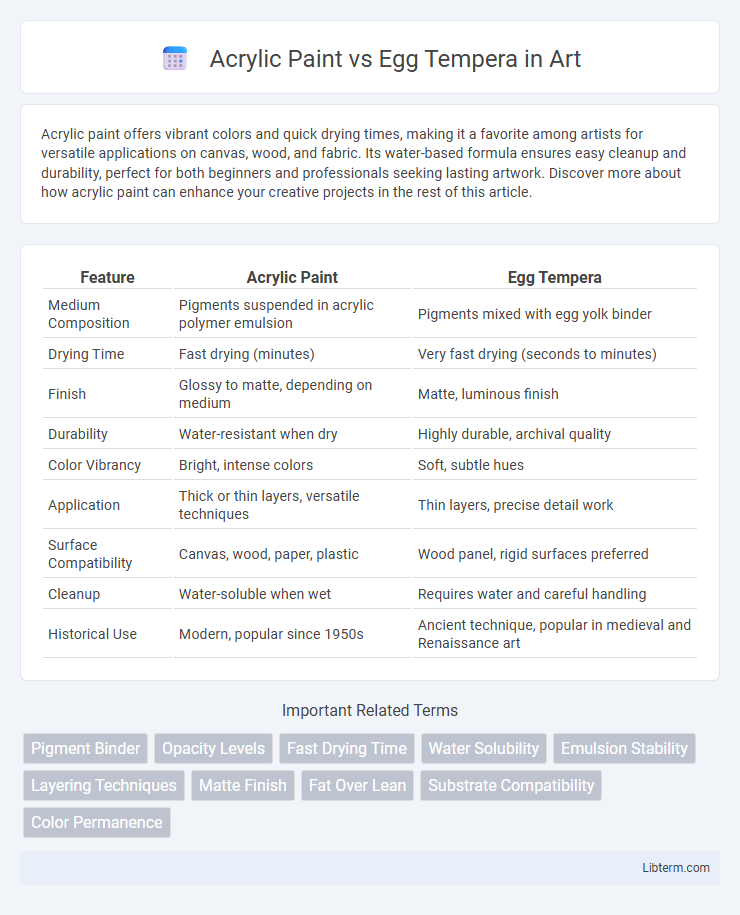Acrylic paint offers vibrant colors and quick drying times, making it a favorite among artists for versatile applications on canvas, wood, and fabric. Its water-based formula ensures easy cleanup and durability, perfect for both beginners and professionals seeking lasting artwork. Discover more about how acrylic paint can enhance your creative projects in the rest of this article.
Table of Comparison
| Feature | Acrylic Paint | Egg Tempera |
|---|---|---|
| Medium Composition | Pigments suspended in acrylic polymer emulsion | Pigments mixed with egg yolk binder |
| Drying Time | Fast drying (minutes) | Very fast drying (seconds to minutes) |
| Finish | Glossy to matte, depending on medium | Matte, luminous finish |
| Durability | Water-resistant when dry | Highly durable, archival quality |
| Color Vibrancy | Bright, intense colors | Soft, subtle hues |
| Application | Thick or thin layers, versatile techniques | Thin layers, precise detail work |
| Surface Compatibility | Canvas, wood, paper, plastic | Wood panel, rigid surfaces preferred |
| Cleanup | Water-soluble when wet | Requires water and careful handling |
| Historical Use | Modern, popular since 1950s | Ancient technique, popular in medieval and Renaissance art |
Introduction to Acrylic Paint and Egg Tempera
Acrylic paint, a versatile medium composed of pigment suspended in an acrylic polymer emulsion, dries quickly and offers vibrant color durability suitable for various surfaces. Egg tempera, an ancient painting technique, mixes pigment with egg yolk, creating a fast-drying, matte finish known for its fine detail and longevity. While acrylic allows flexible layering and water resistance, egg tempera requires meticulous application and excels in luminosity and archival quality.
Historical Origins and Development
Acrylic paint, developed in the mid-20th century, revolutionized art with its fast-drying, water-soluble properties, contrasting with egg tempera, an ancient medium dating back to the first centuries AD, prized for its luminous, long-lasting qualities. Egg tempera, made by mixing pigment with egg yolk, was the primary painting method in Europe before the advent of oil paints during the Renaissance. Acrylics evolved from synthetic polymer emulsions, enabling artists to achieve greater versatility and vibrant colors while maintaining durability and resistance to yellowing over time.
Composition and Ingredients
Acrylic paint consists of pigment suspended in an acrylic polymer emulsion, offering quick drying time and water resistance when dry. Egg tempera is made by mixing ground pigments with egg yolk as a binder, resulting in a fast-drying, durable paint with a matte finish. The key difference lies in the modern synthetic acrylic medium versus the traditional natural protein-based egg yolk binder.
Application Techniques and Methods
Acrylic paint dries quickly and allows for versatile application techniques such as layering, glazing, and impasto, enabling artists to build texture and depth efficiently. Egg tempera requires precise brushwork and is applied in thin, semi-transparent layers, often involving cross-hatching and stippling, to achieve luminous, detailed effects. Both mediums benefit from a rigid support like wood panels, but acrylic's flexibility suits canvas while egg tempera's fast drying time demands meticulous planning and rapid execution.
Drying Time and Layering Capabilities
Acrylic paint dries significantly faster than egg tempera, typically within 15 to 30 minutes, allowing artists to apply multiple layers in a short period. Egg tempera, known for its longer drying time of several hours, requires careful layering to build up rich, luminous effects without blending. The quick drying of acrylics supports rapid layering and textural experimentation, while egg tempera's gradual drying enhances precision and durability in fine detail work.
Durability and Longevity
Acrylic paint offers superior durability due to its synthetic polymer base, resisting cracking, fading, and moisture damage over time, making it ideal for outdoor and high-traffic artworks. Egg tempera, composed of pigment mixed with egg yolk, creates a rigid, matte surface that can be incredibly long-lasting but is more susceptible to cracking and environmental damage if not properly sealed. Museums often preserve ancient egg tempera works by controlling humidity and light exposure, while acrylic paintings typically require less specialized care to maintain their longevity.
Color Vibrancy and Finish
Acrylic paint offers intense color vibrancy with a glossy finish that enhances brightness and depth, maintaining its saturation over time due to its synthetic composition. Egg tempera provides a matte finish with softer, more muted tones, creating a luminous effect through its fine layering technique and natural pigments. While acrylics dry quickly and resist cracking, egg tempera's delicate, archival quality with subtle color shifts appeals to artists seeking historical authenticity.
Surface Compatibility
Acrylic paint adheres well to diverse surfaces such as canvas, wood, metal, and plastic due to its flexible and durable nature. Egg tempera requires rigid, non-absorbent surfaces like gessoed wooden panels or heavy paper to prevent cracking and ensure longevity. Surface preparation is crucial for both mediums, with acrylic offering more versatility and egg tempera demanding traditional, rigid supports for optimal performance.
Environmental and Health Considerations
Acrylic paint contains synthetic polymers and solvents that release volatile organic compounds (VOCs), potentially impacting indoor air quality and posing respiratory risks with prolonged exposure. Egg tempera, made from natural egg yolk and pigment powders, is biodegradable and free from toxic chemicals, making it a safer choice for artists concerned about health and environmental sustainability. Disposal of acrylic paint requires careful handling to prevent water pollution, whereas egg tempera offers an eco-friendly alternative with minimal environmental footprint.
Choosing the Right Medium for Your Art
Acrylic paint offers fast drying times, vibrant colors, and versatile application on various surfaces, making it ideal for artists seeking durability and ease of use. Egg tempera provides a luminous finish with fine detail and archival longevity, favored in traditional and classical painting techniques. Choosing the right medium depends on your desired texture, drying time, and the longevity of your artwork.
Acrylic Paint Infographic

 libterm.com
libterm.com